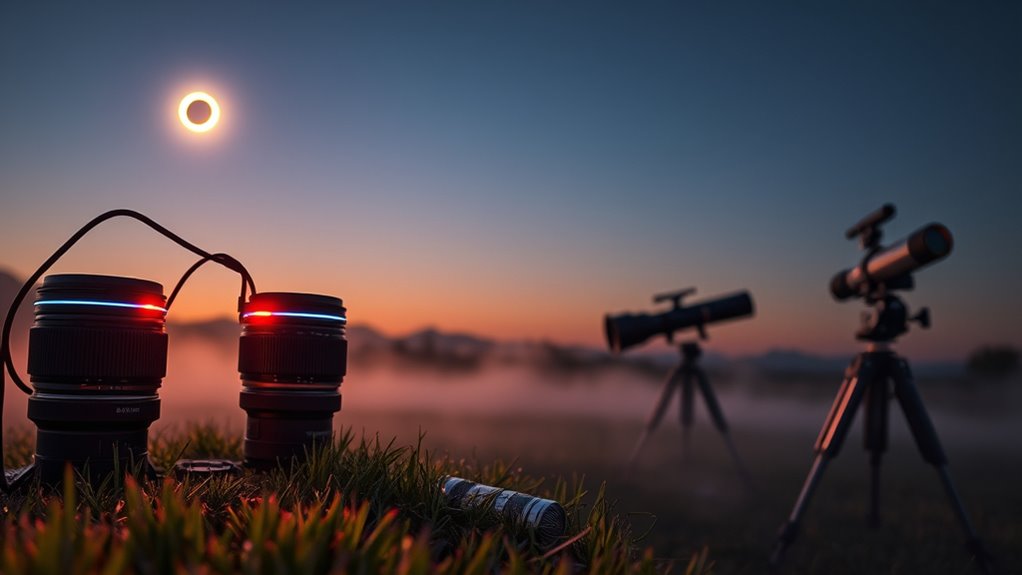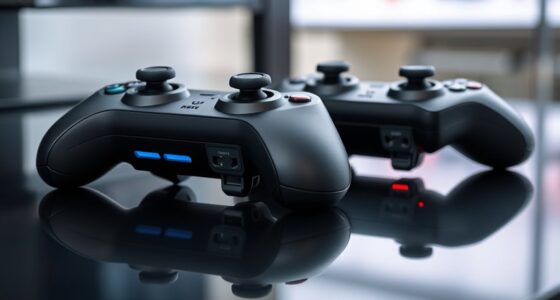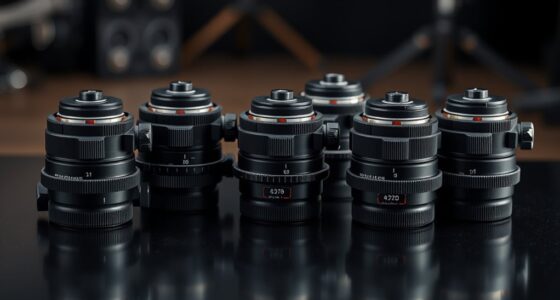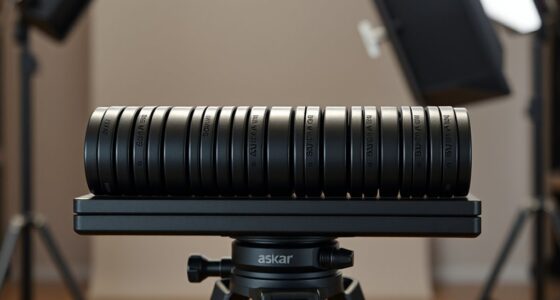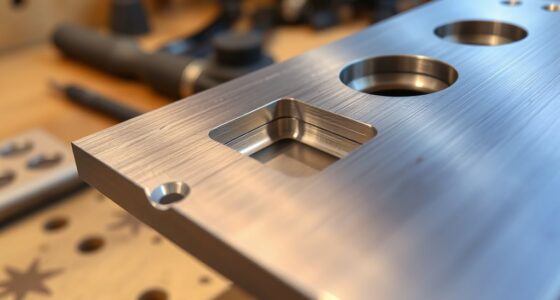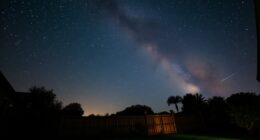When it comes to eclipse watching, I rely on effective dew heaters to keep my optics clear and sharp. I look for models that fit my lenses or telescopes properly, offer adjustable temperature control, and run reliably on portable power sources like USB or batteries. Durability and easy installation are also top priorities. If you keep these factors in mind, you’ll find the perfect dew heater to avoid dew buildup and stay focused on the sky. Stick around to learn about the top options.
Key Takeaways
- Choose heaters compatible with your lens or telescope size to ensure full coverage and effective dew prevention.
- Opt for models with adjustable temperature settings for precise control in varying outdoor conditions.
- Prioritize lightweight, portable heaters powered via USB or batteries for outdoor eclipse viewing convenience.
- Select durable, weatherproof designs to withstand outdoor elements during critical eclipse moments.
- Proper installation and secure attachment ensure consistent performance and clear views during the celestial event.
Astromania 25 cm DC Lens Heater Warmer Dew Heater Strip
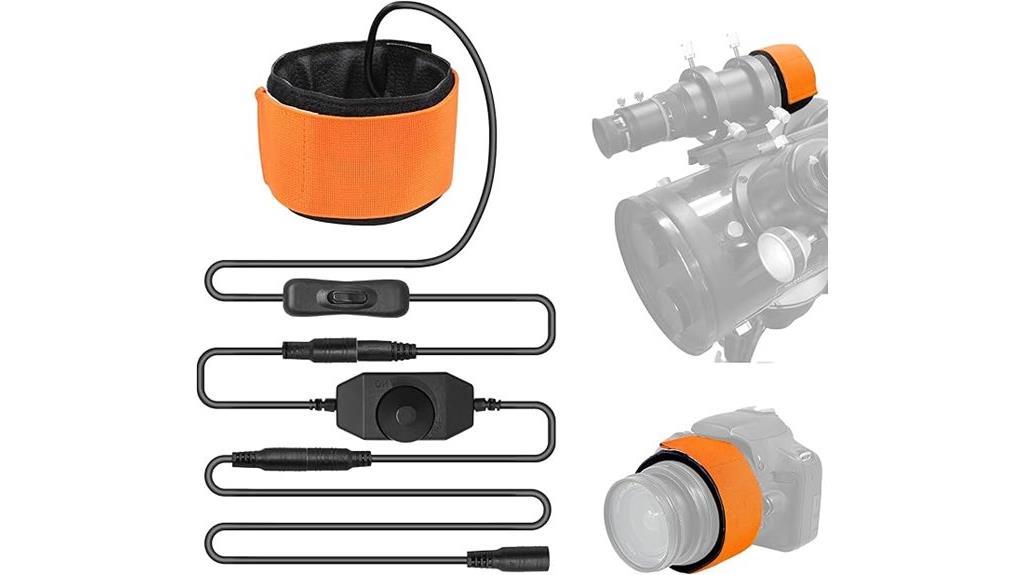
If you’re looking for an affordable and easy-to-implement dew prevention solution for your telescope or camera, the Astromania 25 cm DC Lens Heater Warmer Dew Heater Strip is a solid choice. It’s compatible with scopes and lenses under 80mm in diameter, making it versatile for many setups. The heater features stepless temperature control via a sliding knob, allowing precise adjustments. It’s lightweight and simple to install or remove, connecting easily to power banks or DC outlets. While it effectively prevents dew formation in high-humidity conditions, some users report overheating and inconsistent regulation. Overall, it’s a budget-friendly option that works well with basic dew prevention needs.
Best For: amateur astronomers and photographers seeking an affordable, easy-to-use dew prevention solution for scopes and lenses under 80mm in diameter.
Pros:
- Simple installation and removal with adjustable length for versatile fit
- Stepless temperature control for precise regulation
- Compatible with portable power sources like power banks for mobility
Cons:
- Reports of overheating and inconsistent regulation of temperature
- Rubber components may emit odors and can leave residues after removal
- Some users find the controller unstable and difficult to calibrate properly
Lens Warmer with Cold Flexible Cable for Astrophotography
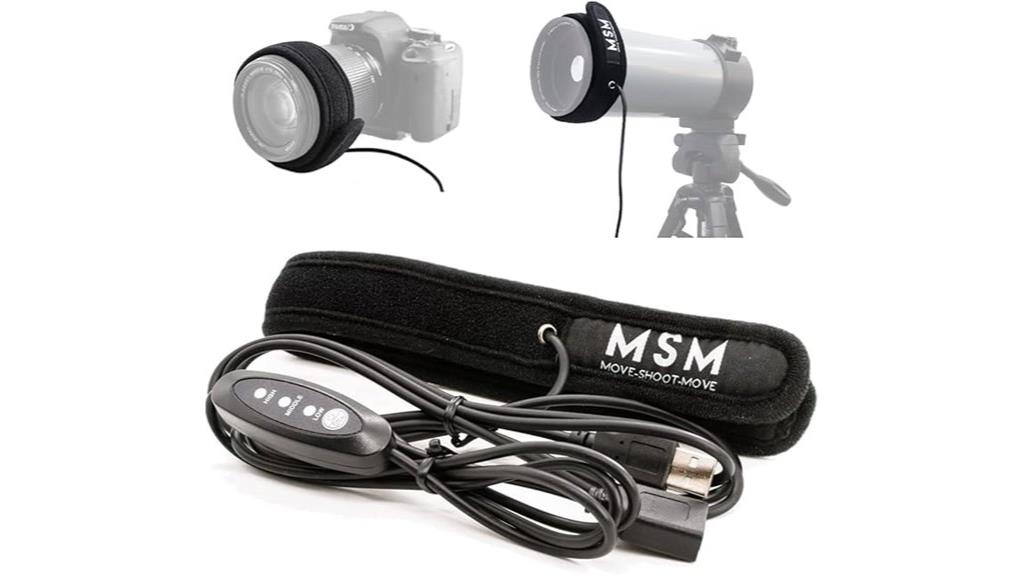
The Lens Warmer with Cold Flexible Cable is an ideal choice for astrophotographers who need reliable dew prevention during long exposures in cold, humid conditions. Its 350mm dew heater strip can reach temperatures down to -25℃, effectively preventing dew, fog, and condensation. Made of premium neoprene, it’s soft, flexible, and fits lenses up to 4.26 inches in diameter. The quick-attach adhesive strap makes setup easy, and the USB power option offers portability with minimal energy use. With adjustable temperature controls and intelligent regulation to 167°F, it ensures your lens stays dry and clear, so you can focus on capturing stunning night skies without interruption.
Best For: astrophotographers who need a reliable, portable solution to prevent lens dew and condensation during long exposure night sky photography in cold, humid environments.
Pros:
- Effective down to -25℃ with flexible, quick-attach neoprene design for versatile lens fit
- Adjustable temperature control with intelligent regulation ensures optimal warmth and energy efficiency
- USB-powered, portable, lightweight, and easy to set up for quick deployment in outdoor settings
Cons:
- Limited to lenses up to 4.26 inches in diameter, may not fit larger equipment
- Requires a USB power source, which may necessitate additional accessories for some users
- Does not include a dedicated battery pack, so continuous use depends on external power availability
SVBONY SV172 Dew Heater Strip for Telescopes and Camera Lenses
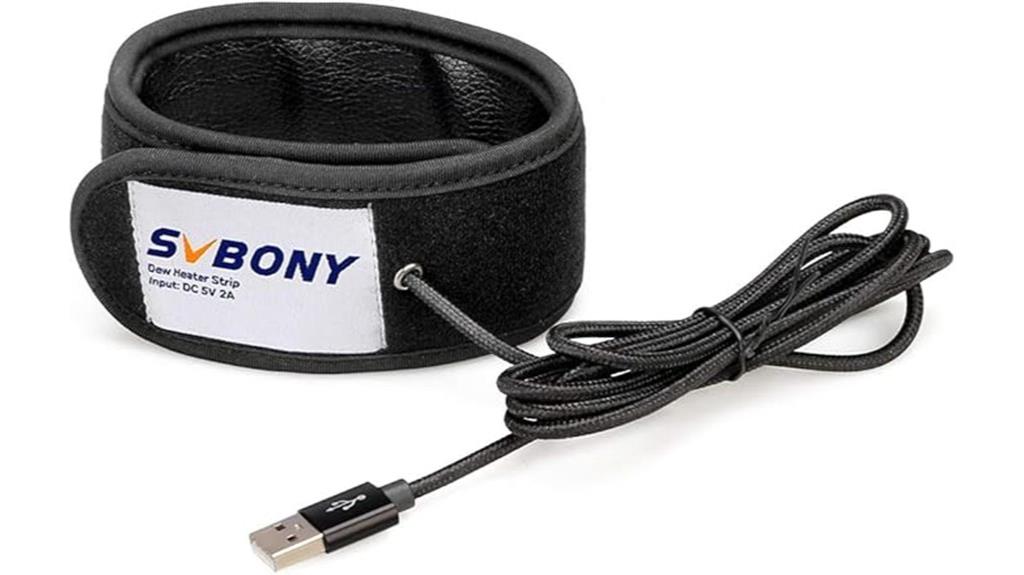
The SVBONY SV172 Dew Heater Strip stands out as an excellent choice for astronomers and astrophotographers who need reliable, even heating for their telescopes and camera lenses. Its 320 mm aluminum film guarantees uniform warmth with no dead spots, preventing fogging and dew buildup. The three-speed adjustment lets me customize the heat level, while quick startup provides instant warming. Made with alloy fiber wiring and silicone insulation, it’s safe and durable. Connecting via USB makes it versatile—power from a power bank, laptop, or car charger. Its narrow 50mm width keeps focus clear without interfering with accessories, making it perfect for eclipse viewing and astrophotography.
Best For: amateur astronomers and astrophotographers who need reliable, even heating for their telescopes and camera lenses to prevent dew and fogging during observation and photography sessions.
Pros:
- Provides uniform heating with no dead spots thanks to built-in aluminum film.
- Offers three adjustable heat settings for customized performance.
- USB-powered for versatile use with power banks, laptops, or car chargers.
Cons:
- Narrow 50mm width may require careful placement to avoid interference with focus and accessories.
- Limited to 320 mm length, which may not suit larger lenses or telescopes.
- Requires a USB power source, which might not be convenient in all outdoor settings.
NEEWER USB Lens Heater for DSLR and Telescope
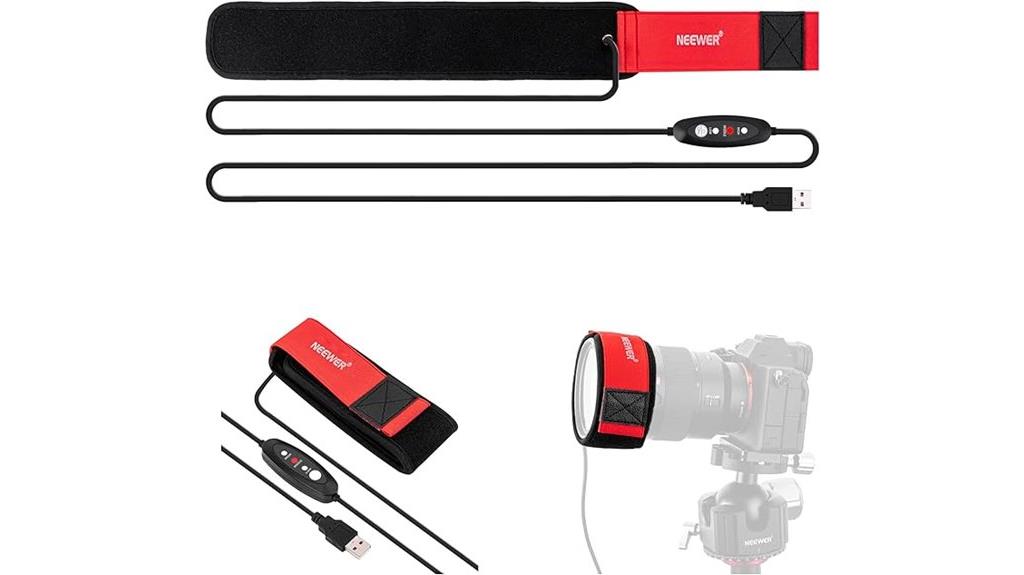
For astrophotographers and eclipse watchers seeking a reliable, portable solution, the NEEWER USB Lens Heater stands out with its adjustable temperature levels and easy-to-secure fasteners. It’s compatible with DSLR cameras and telescopes, effectively preventing dew, fog, and condensation on lenses up to 10.8 inches in circumference. The heater features three temperature settings—high, middle, and low—so you can customize the warmth as needed. Powered via a USB connection, it works with portable chargers or adapters, making it ideal for outdoor use. Its lightweight design and adjustable fasteners make setup quick and secure, ensuring clear views during your eclipse observation.
Best For: astrophotographers, eclipse watchers, and outdoor photographers seeking an effective, portable dew prevention solution for DSLR lenses and telescopes.
Pros:
- Adjustable temperature levels (high, middle, low) for customizable performance
- Easy-to-secure fasteners ensure quick, stable setup around lenses or scopes
- Compact, lightweight design (about 100 grams) for portability and outdoor use
Cons:
- Limited to lenses and telescopes with a circumference up to 10.8 inches (275mm)
- Requires a USB power source, which may need compatible portable chargers or adapters
- Does not include a power supply; must be purchased separately for full operation
USB Lens Warmer, Dew Heater Strip for Telescopes and DSLR Lenses

If you’re an astrophotographer or outdoor enthusiast who needs reliable dew prevention, the USB Lens Warmer and Dew Heater Strip offers a practical solution. Designed for telescopes, DSLR lenses, and other items up to 80mm in diameter, it effectively prevents fogging and dew formation in cold environments. With a 1.5m USB-powered cable and three heat settings, you can easily adjust the warmth for your needs. Made from high-quality materials, it heats quickly and maintains consistent temperature, even in temperatures as low as -40°C. Its portable design and easy installation make it ideal for night sky photography, ensuring your lenses stay clear during long outdoor sessions.
Best For: astrophotographers and outdoor enthusiasts seeking reliable dew prevention for telescopes and DSLR lenses in cold environments.
Pros:
- Effective at preventing fogging and dew formation during long outdoor sessions
- Compatible with various USB power sources, including power banks and portable batteries
- Easy to install, lightweight, and portable, making it suitable for outdoor use
Cons:
- May require high mode for extended use to avoid power shutdowns on some power banks
- Short heating strip length may need precise positioning for optimal coverage
- Controller responsiveness issues reported by some users, requiring careful operation
SVBONY SV192 Dew Heater Strip for Telescope and DSLR Lenses
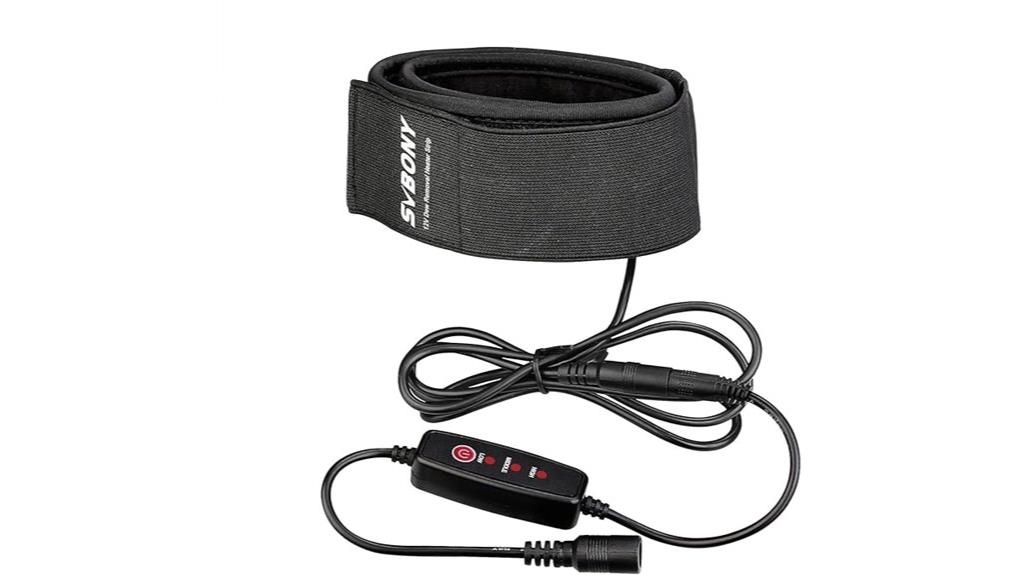
Designed specifically for large aperture camera lenses and telescopes, the SVBONY SV192 Dew Heater Strip guarantees reliable dew prevention during eclipse viewing sessions. Its 560mm length fits lenses with outer diameters below 178mm, ensuring broad compatibility. Built-in aluminum promotes even heating, while alloy fiber wiring delivers rapid warmth. The three-layer insulation minimizes heat loss, enhancing efficiency and safety. With a 120cm TPE cord and a DC 5.5×2.1mm interface supporting 12V, setup is straightforward. The heater offers fast, uniform heat with adjustable modes—strong, medium, and weak—so you can customize the temperature for ideal clarity during your celestial observation.
Best For: Amateur astronomers and astrophotographers seeking reliable dew prevention for large aperture lenses and telescopes during celestial observations.
Pros:
- Provides even and rapid heating to prevent dew formation effectively.
- Compatible with lenses and telescopes up to 178mm in diameter, offering broad usability.
- Adjustable heat modes allow customization for optimal viewing conditions.
Cons:
- Limited to lenses with outer diameters below 178mm, not suitable for larger equipment.
- Requires a 12V power source with a compatible DC 5.5×2.1mm interface, which may necessitate additional adapters.
- Narrow 50mm width might pose compatibility issues with some larger or uniquely shaped accessories.
Celestron Smart DewHeater Controller 2X

The Celestron Smart DewHeater Controller 2X stands out for astronomers who want precise, automatic dew prevention without constantly monitoring conditions. It uses real-time data to adjust heat levels on dew heaters, extending battery life and ensuring clear views. Its smart control system monitors ambient temperature and humidity, automatically tuning power to maintain ideal conditions. Compatible with Celestron Dew Heater Rings, third-party bands, and straps with thermistor accessories, it supports two dew heaters and an extra 12V device. Easily connect it to Celestron’s hand control or CPWI software, allowing you to view environmental data and make adjustments effortlessly, making it a reliable dew prevention tool.
Best For: astronomers and astrophotographers seeking automatic, precise dew prevention to maintain clear viewing conditions during observations and imaging sessions.
Pros:
- Automatically adjusts heat levels based on real-time ambient temperature and humidity data, reducing manual intervention.
- Supports integration with Celestron telescope hand control and CPWI software for seamless operation.
- Compatible with multiple heating accessories, including Celestron Dew Heater Rings and third-party thermistor-equipped straps.
Cons:
- Limited to supporting only two dew heaters and one additional 12V device, which may be restrictive for large setups.
- Requires compatible heating accessories with thermistor accessories for optimal performance.
- May involve a learning curve for users unfamiliar with smart control systems or software integration.
Dew Heater Strip – 6.5 Length # DN02
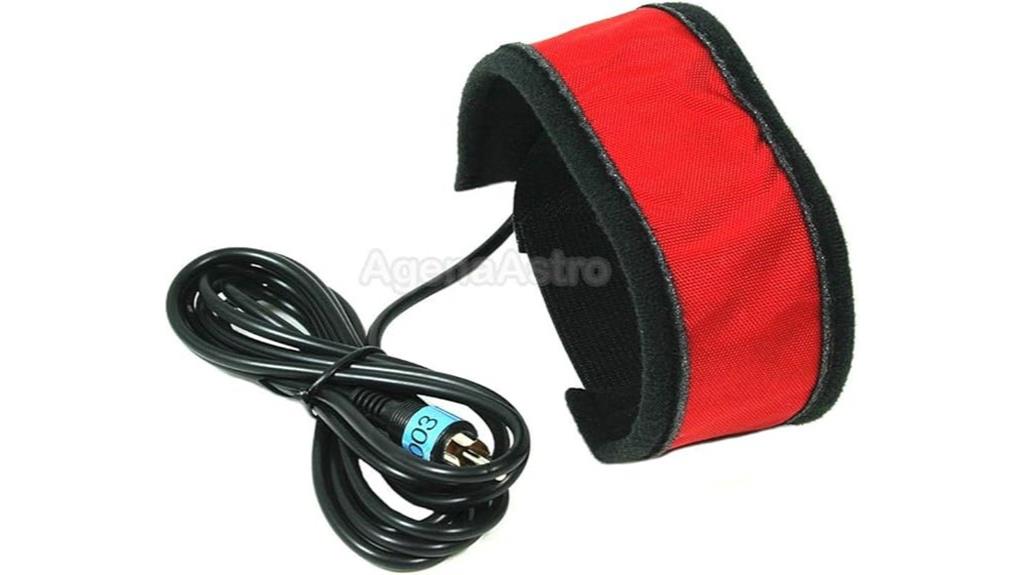
The Dew Heater Strip – 6.5 Length # DN02 is an ideal choice for astronomers seeking effective dew prevention on smaller optics like eyepieces and finderscopes. Made in the USA by AFAB, it delivers even heat distribution at 12 volts, avoiding hot spots or burnouts. Its compact design ensures it barely warms during operation, providing reliable dew control without risking damage. Proper sizing is key, so measure your device’s circumference before ordering. With over 20 years of development and protected by numerous patents, this durable, cost-effective heater is perfect for keeping your optics clear during those critical eclipse moments.
Best For: amateur astronomers and stargazers seeking reliable dew prevention for small optics like eyepieces and finderscopes during observations.
Pros:
- Provides even heat distribution at 12 volts, preventing hot spots and burnouts
- Compact and lightweight design, barely warms during operation for safety
- Made in the USA with over 20 years of development and protected by numerous patents
Cons:
- Requires a separate 12V power supply with a female RCA connector (not included)
- Proper sizing depends on precise circumference measurement; inaccurate sizing may reduce effectiveness
- Limited to devices up to approximately 16-inch aperture, not suitable for larger telescopes
Dew Heater for Camera Lens and Observation Mirrors
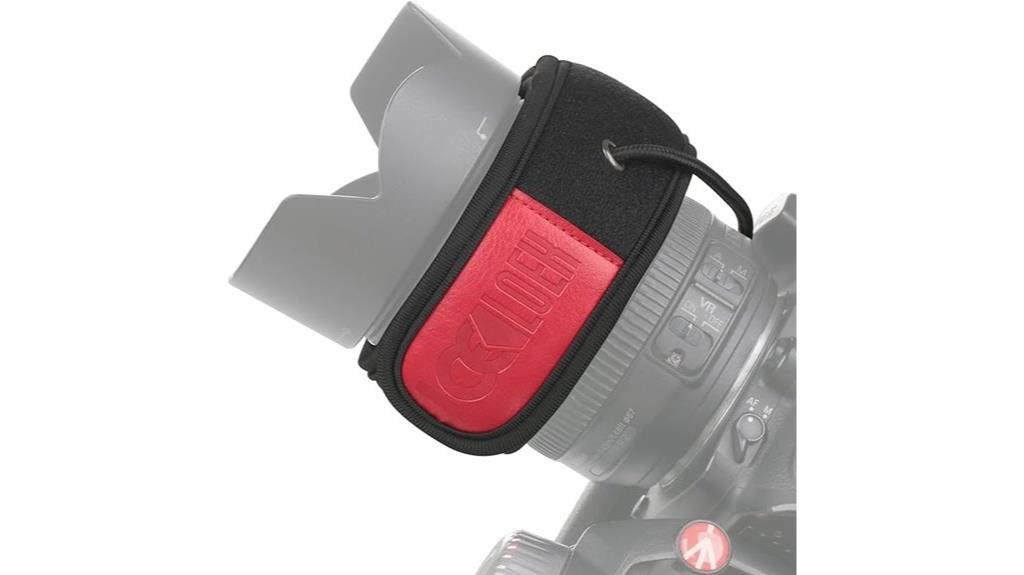
If you’re serious about capturing clear, fog-free images during outdoor eclipse viewing or astrophotography, a dew heater for your camera lens and observation mirrors is essential. The LOSHARP Lens Heater quickly heats to around 122°F, effectively preventing dew and condensation without wasting power. It’s compatible with most telescope eyepieces, camera lenses, and finders, and attaches easily with velcro for quick setup. Powered via USB from a power bank, it offers reliable, consistent warmth in cold or humid conditions. Its compact design makes it convenient to carry and use outdoors, ensuring your optics stay clear so you can focus on the celestial event.
Best For: outdoor astrophotographers, astronomers, and eclipse viewers who need reliable dew prevention for their lenses and observation mirrors in cold or humid conditions.
Pros:
- Quick heating capability reaching 122°F within seconds to prevent dew formation effectively.
- Compatible with most telescope eyepieces, camera lenses, and finders, with easy velcro attachment for quick setup.
- Powered via USB, allowing flexible outdoor use with power banks or USB adapters, and designed for durability and portability.
Cons:
- Lacks an on/off switch or temperature control, which may lead to unnecessary power consumption or difficulty managing heat levels.
- Short wire length can limit positioning flexibility during use.
- Some users have reported switch failure after prolonged exposure to rain or extended use, requiring potential replacement or repair.
JJC USB Lens Warmer for 80mm Lenses
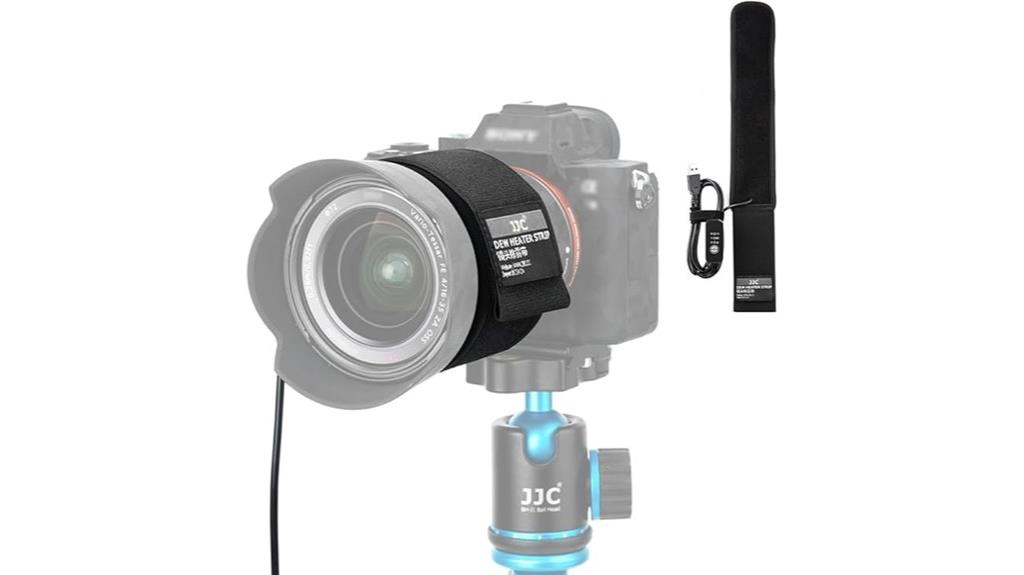
For astrophotographers and telescope enthusiasts working with lenses up to 80mm in diameter, the JJC USB Lens Warmer offers an efficient solution to prevent condensation during cold outdoor sessions. Made from high-quality materials, it heats lenses quickly and maintains thermal insulation, ensuring clear images even in freezing temperatures. Its three adjustable heat levels, including a low setting that works down to -40°C, provide precise temperature control. Powered via USB, it’s compatible with power banks for extended use in the field. Besides lenses, I’ve used it to insulate thermoses and bottles, making it a versatile tool for outdoor activities beyond astrophotography.
Best For: astrophotographers and telescope enthusiasts needing reliable condensation prevention for lenses up to 80mm in diameter during cold outdoor sessions.
Pros:
- Rapid heating and excellent thermal insulation from high-quality materials
- Adjustable three-level temperature control, with a low setting down to -40°C
- USB-powered for convenient use with power banks, suitable for extended outdoor operation
Cons:
- Limited to lenses with a maximum diameter of 80mm, not suitable for larger lenses
- May require additional accessories or power banks for longer field use
- Primarily designed for cold environments, less effective in milder conditions
COOWOO Lens Heater Warmer Dew Heater Strip with Temperature Regulator
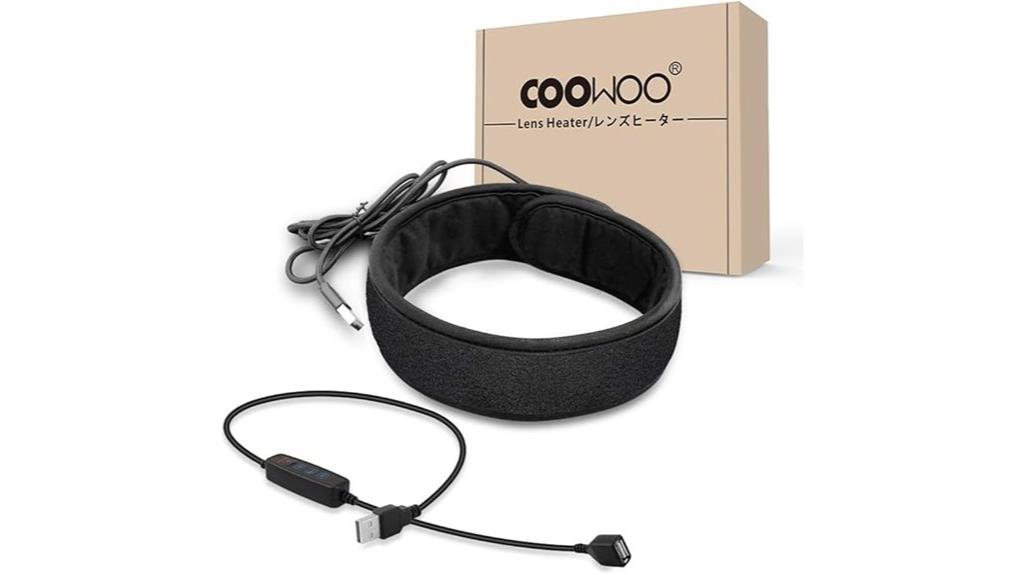
Designed for outdoor photographers and astronomers, the COOWOO Lens Heater Warmer Dew Heater Strip with Temperature Regulator offers an effective solution to prevent lens fogging and ice buildup. Made from durable neoprene, polyester, and cotton, it’s certified with CE and RoHs standards. The narrow strip measures about 43 cm and connects easily via USB to power banks or chargers. With an adjustable temperature regulator, I can choose low, medium, or high modes, reaching up to 60°C within minutes. It’s simple to use, lightweight, and versatile—perfect for cold, humid nights during eclipse viewing or astrophotography sessions.
Best For: outdoor photographers and astronomers seeking a reliable solution to prevent lens fog and ice buildup during cold or humid conditions.
Pros:
- Effective at preventing lens fogging and ice formation in various weather conditions
- Easy to use with adjustable temperature settings and USB power connection
- Made from durable, high-quality materials with CE and RoHs certification
Cons:
- Slightly shorter in length than advertised, which may affect fit on larger lenses
- Limited heating capacity, may not fully prevent condensation in extreme cold
- Battery drain can occur during extended use, reducing operational time
Astromania USB Lens Heater Warmer Dew Heater Strip (30cm)
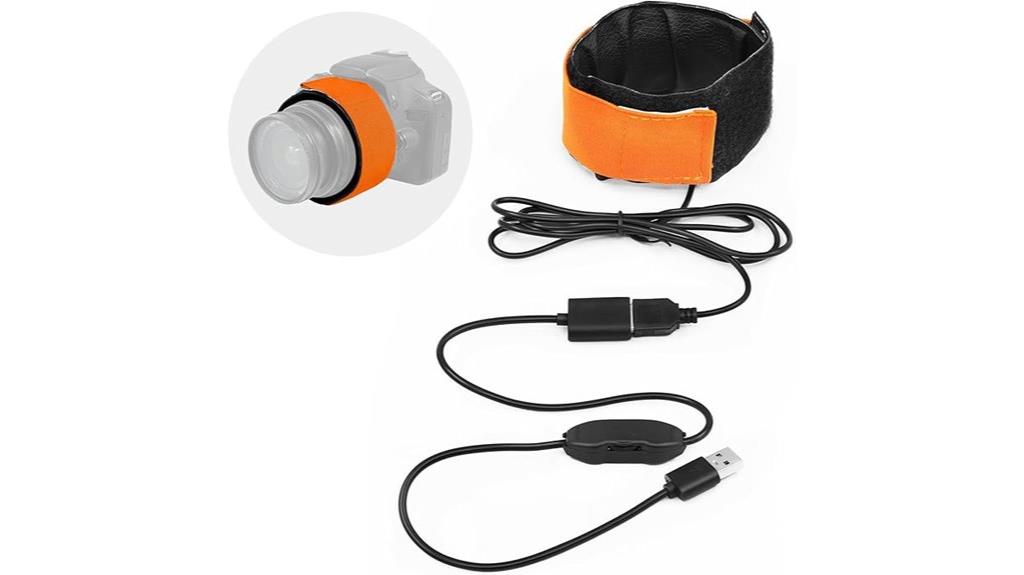
The Astromania USB Lens Heater Warmer Dew Heater Strip (30cm) stands out as an excellent choice for eclipse enthusiasts who need reliable lens protection in cold or humid conditions. Its stepless temperature regulation lets me precisely control heat levels, preventing lens fogging or freezing. Suitable for lenses under 95mm in diameter, it’s compatible with most cameras and telescopes. The USB power connection makes it portable, easily linking to power banks for outdoor use. I appreciate its multi-purpose design—perfect for warming lenses, water bottles, or even acting as a cold-weather wrist strap. This heater keeps my optics clear, ensuring sharp images during those critical eclipse moments.
Best For: outdoor astronomers, eclipse enthusiasts, and astrophotographers seeking reliable lens protection in cold or humid conditions.
Pros:
- Precise stepless temperature regulation for optimal heating control
- Compatible with lenses up to 95mm in diameter and versatile for various optical equipment
- USB-powered design offers portability and easy connection to power banks for field use
Cons:
- Limited to lenses with an outer diameter less than 95mm, not suitable for larger lenses
- Requires a USB power source, which may necessitate additional accessories in remote locations
- May need careful adjustment to avoid overheating or uneven heating during extended use
250mm DC Lens Heater Warmer Dew Heater Strip for Telescopes and Camera Lenses
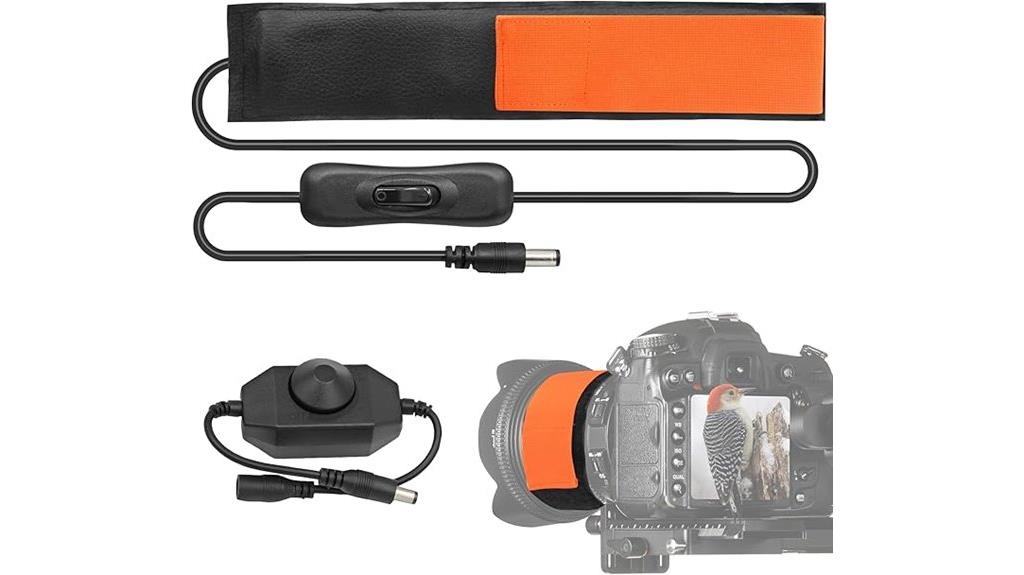
If you’re looking for an affordable and reliable solution to prevent dew on your telescope or camera lenses, the 250mm DC Lens Heater Warmer Dew Heater Strip is a smart choice. Designed for lenses with an outer diameter under 80mm, it fits most telescopes and cameras. The stepless temperature control allows easy adjustments, while the LED dimmer ensures precise heat levels. Powered via a DC port, it’s easy to connect to power banks or other sources. Weighing just over 4 ounces, it’s lightweight and portable. Many users find it effective for fog, dew, and freezing conditions, making it a budget-friendly option for amateur astronomers and photographers alike.
Best For: amateur astronomers and photographers seeking an affordable, effective dew prevention solution for lenses and telescopes under 80mm in diameter.
Pros:
- Easy to adjust with stepless temperature control for customized heating.
- Compatible with various power sources via DC port, including power banks.
- Lightweight and portable, making it convenient for outdoor use.
Cons:
- Designed for lenses with outer diameters less than 80mm, limiting use on larger equipment.
- Supports around 2 amps, which may be insufficient for higher heat requirements.
- Some users suggest turning the heater off with the switch rather than the dimmer for better control.
NEEWER USB Lens Heater for DSLR Camera and Telescope
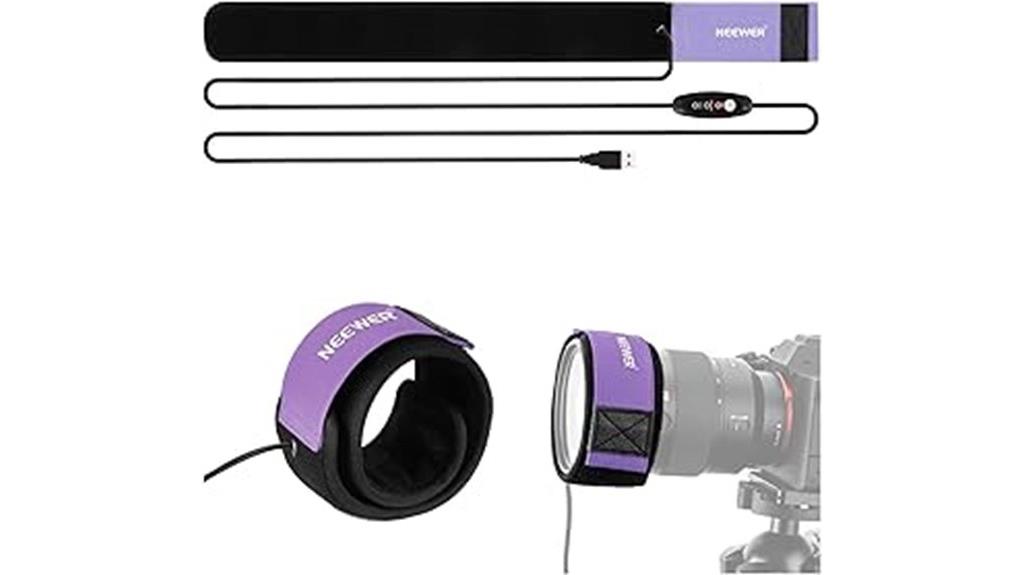
For astrophotographers who need a lightweight, portable solution to prevent lens fogging during cold weather, the NEEWER USB Lens Heater for DSLR cameras and telescopes offers an effective option. Made with flexible printed circuits, it provides reliable, even heat distribution without adding bulk. The 18-inch wrap can fit lenses up to 12 inches in circumference, attaching securely with a touch fastener. It features three temperature settings—high, medium, and low—regulated via a built-in controller. Powered by a 5V 2A USB source, it’s compatible with power banks for extended use. While some report temperature inconsistencies, overall, it’s a convenient tool to keep lenses clear during night sky observations.
Best For: astrophotographers and cold-weather outdoor enthusiasts seeking a lightweight, portable solution to prevent lens fogging on cameras and telescopes.
Pros:
- Easy to attach securely with touch fastener and flexible design fits various lens sizes
- Powered by standard USB sources, compatible with power banks for extended use
- effectively prevents dew and fogging during night sky observations and cold conditions
Cons:
- Temperature regulation relies on cycling power, which may lead to inconsistent warmth
- Some users report it does not reach the advertised maximum temperature or sustain warmth over long periods
- Limited to lenses with up to 12 inches circumference; larger lenses may require a longer strip
Factors to Consider When Choosing a Dew Heater for Eclipse
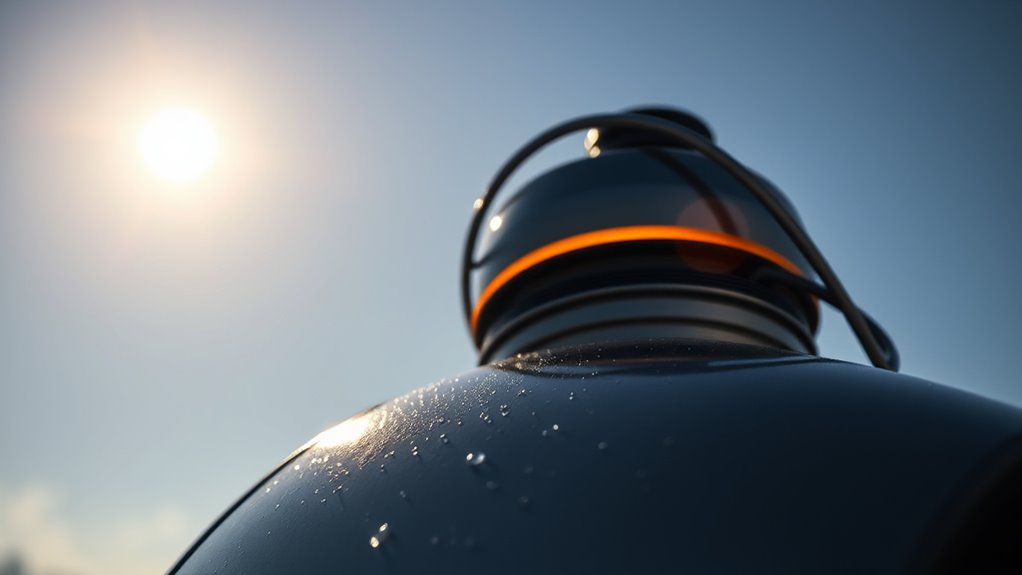
When selecting a dew heater, I focus on compatibility with my equipment to guarantee it fits and works properly. I also look for adjustable temperature settings and flexible power options to adapt to different conditions. Finally, I consider size, durability, and build quality to make sure it’s reliable and easy to handle during the eclipse night.
Compatibility With Equipment
Choosing a dew heater that fits your equipment properly is essential to guarantee reliable performance during eclipse viewing. First, check that the outer diameter or length matches your telescope, camera, or lens to ensure proper coverage and secure attachment. Next, verify that the heater’s power requirements align with your power sources, whether USB, DC, or 12V adapters, to avoid connection issues. Compatibility with your equipment‘s material and design is also crucial; flexible or rigid structures may require different mounting solutions. Additionally, consider the control features like temperature regulation to suit your operational preferences. Finally, ensure the connectivity interface, such as USB or specialized connectors, integrates seamlessly with your gear. Proper compatibility prevents mishaps and ensures your equipment stays clear and focused during the eclipse.
Adjustable Temperature Settings
Adjustable temperature settings give you precise control over your dew heater’s performance, helping you prevent overheating and dew buildup effectively. With multiple levels like low, medium, and high, you can tailor the heat output to match environmental conditions and lens sizes. Stepless regulation through sliding knobs or digital controls allows for finer adjustments, ensuring ideal performance. Properly adjustable heaters conserve power by reducing unnecessary heat, which extends both the device’s lifespan and your power source’s life. Being able to modify temperature settings also helps prevent thermal damage during prolonged outdoor use, especially when observing for extended periods. This flexibility ensures your equipment stays clear without risking overheating, making adjustable dew heaters a crucial feature for a successful and hassle-free eclipse viewing experience.
Power Source Flexibility
A versatile power source is essential for dew heaters, especially during eclipse viewing where reliable operation is critical. I look for heaters that support common inputs like USB or DC, allowing me to connect to various power banks, portable batteries, or external power supplies. Compatibility with different voltage levels, such as 5V or 12V, is also key, ensuring the heater works in diverse outdoor conditions. Supporting standard connectors like USB, DC, or RCA makes setup easier and reduces the need for adapters. It’s also important to contemplate power draw; a heater that demands high amperage needs a sufficiently capable power source to prevent shutdowns or overheating. Overall, a flexible power setup extends operation time and provides peace of mind during those long, awe-inspiring eclipse moments.
Size and Length Options
Selecting the right size and length for a dew heater is essential to guarantee effective coverage and prevent dew buildup. Dew heaters come in various lengths, from about 6.5 inches to over 25 centimeters, designed to fit different lenses and dew shields. To choose the correct length, measure the circumference of your lens or dew shield to ensure full coverage without excess material. Longer heater strips distribute heat more evenly over larger surfaces, reducing dew risks on wide lenses. Shorter heaters are ideal for smaller lenses or finderscopes, making installation easier and minimizing bulk during observation. Matching the heater’s length to your device’s size ensures adequate coverage without overheating, providing reliable dew prevention and clearer views during your eclipse viewing.
Durability and Build Quality
When choosing a dew heater for eclipse viewing, durability and build quality are essential factors that guarantee reliable performance over time. I look for heaters made from high-quality materials like neoprene, silicone, or alloy fibers, which resist wear, cracking, and environmental damage. Strong construction includes secure wiring, reinforced connectors, and protective insulation, preventing short circuits and guaranteeing longevity. Weatherproof features, often indicated by CE and RoHS certifications, signal resistance to moisture, humidity, and temperature changes. Additionally, a well-designed heater distributes heat evenly, avoiding hot spots that could degrade materials. Ease of installation and removal is also important, with flexible components that withstand repeated use without losing effectiveness. Overall, solid build quality ensures my dew heater remains dependable during crucial eclipse moments.
Frequently Asked Questions
How Long Do Dew Heaters Typically Last During an Eclipse?
Dew heaters usually last between 4 to 8 hours during an eclipse, depending on their power settings and the ambient conditions. I recommend checking the manufacturer’s specifications for your specific model. To guarantee continuous performance, bring extra batteries or a portable power source. I always prepare for longer sessions by carrying backup power, so I stay focused on the sky rather than worrying about losing heat.
Are There Portable Dew Heater Options for Remote Eclipse Viewing?
Imagine carrying a tiny guardian for your telescope—yes, portable dew heaters do exist. I’ve used battery-powered options that easily fit into a backpack, perfect for remote eclipse viewing. They keep your gear clear of dew without tethering you to power outlets. These compact heaters are like your trusty sidekick, ensuring your focus stays on the sky, not on battling fog or moisture.
Can Dew Heaters Damage Sensitive Telescope Equipment?
Dew heaters can potentially damage sensitive telescope equipment if not used properly. I always make sure to use a controller with temperature regulation, so I don’t overheat my gear. Proper insulation and monitoring are key. I recommend reading your equipment’s manual and choosing a dew heater designed for astronomy gear. When used carefully, dew heaters are safe and prevent moisture damage, keeping my telescope safe during eclipse viewing.
What Safety Features Should I Look for in a Dew Heater?
Safety features in a dew heater are like a guardian angel for your telescope. Look for automatic shut-off functions to prevent overheating, and adjustable temperature controls to keep things just right. Overcurrent protection is key too, guarding against electrical mishaps. I always prioritize models with these features, so I can enjoy my eclipse view without worry, knowing my equipment stays safe and undamaged during those celestial moments.
How Energy-Efficient Are Different Dew Heater Models During Long Sessions?
Different dew heater models vary in energy efficiency, and I’ve found that adjustable settings help conserve power during long sessions. Some models use less wattage while still providing enough warmth, which is great for extended observations. I recommend choosing a heater with a thermostatic control or adjustable power levels. That way, you can maintain clear optics without draining your power source too quickly, making your eclipse viewing more enjoyable and sustainable.
Conclusion
Choosing the right dew heater is like finding a trusted partner for your eclipse adventure—reliable, clear, and steadfast. With the right tool, you’ll keep your lenses fog-free and your focus sharp, turning a fleeting celestial event into a breathtaking memory. Don’t let dew cloud your view; instead, embrace these top options and watch the universe reveal its wonders with perfect clarity. After all, isn’t clear vision the true key to capturing the cosmos?
